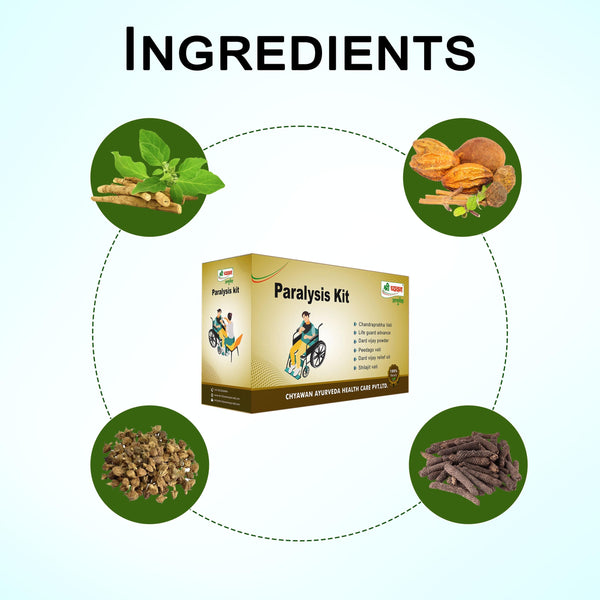Ayurveda, the traditional system of medicine that originated in India, has its own perspective on paralysis. In Ayurveda, paralysis is referred to as "Pakshaghata." According to Ayurvedic principles, paralysis is primarily caused by an imbalance in the three doshas (Vata, Pitta, and Kapha) and a disruption in the flow of vital energy (prana) in the body. Ayurvedic treatments for paralysis aim to restore balance to these doshas and promote the rejuvenation of affected tissues. Here are some key points about paralysis in Ayurveda:
Dosha Imbalance & Paralysis: Ayurveda believes that an imbalance in the Vata dosha is the primary cause of paralysis. Vata is associated with movement and communication within the nervous system. When Vata is aggravated or imbalanced, it can lead to disruptions in nerve function and muscle control.
In Ayurveda, dosha imbalance is believed to play a significant role in the development of paralysis, which is referred to as "Pakshaghata" in Ayurvedic terminology. Paralysis is primarily associated with an imbalance in the Vata dosha. Here's how dosha imbalance is related to paralysis in Ayurveda:
Vata Dosha Imbalance: Vata is one of the three primary doshas in Ayurveda, and it is associated with qualities such as mobility, dryness, coldness, and lightness. Vata governs the nervous system, including the movement of nerve impulses and the coordination of muscle movements. When there is an excessive or aggravated Vata dosha, it can disrupt the normal functioning of the nervous system, leading to conditions like paralysis.
Causes of Vata Imbalance: Several factors can contribute to the imbalance of Vata dosha, including:
-
Physical Trauma: Injuries or trauma to the nervous system, such as spinal cord injuries or head injuries, can directly affect Vata and lead to paralysis.
-
Emotional Stress: High levels of stress, anxiety, and emotional trauma can aggravate Vata dosha and contribute to nervous system disorders.
-
Poor Diet and Lifestyle: Unhealthy dietary habits, irregular routines, and excessive consumption of Vata-aggravating foods (e.g., dry and cold foods) can disturb the balance of Vata dosha.
- Toxins: The accumulation of toxins (ama) in the body due to poor digestion or metabolic issues can also disrupt Vata and lead to health problems, including paralysis.
Paralysis Causes
Paralysis can result from various underlying causes, each of which affects the nervous system or muscles differently. Here are some common causes of paralysis, along with explanations for each:
-
Stroke (Cerebrovascular Accident): A stroke occurs when there is a disruption of blood flow to a part of the brain. This can happen due to a blocked blood vessel (ischemic stroke) or a ruptured blood vessel (hemorrhagic stroke). The affected area of the brain can no longer function properly, leading to paralysis in specific parts of the body. The extent and location of paralysis depend on which area of the brain is affected.
-
Spinal Cord Injury: Trauma or injury to the spinal cord can result in paralysis. The spinal cord is responsible for transmitting signals between the brain and the body. When the spinal cord is damaged, the communication between the brain and muscles is interrupted, leading to paralysis. Paralysis resulting from spinal cord injury can be complete (total loss of function) or incomplete (partial loss of function), depending on the severity and location of the injury.
- Neurological Disorders: Various neurological conditions can lead to paralysis. These include:
-
Multiple Sclerosis (MS): MS is an autoimmune disorder that affects the central nervous system. It can cause episodes of weakness or paralysis due to damage to the protective covering of nerve fibres (myelin).
-
Amyotrophic Lateral Sclerosis (ALS): ALS is a progressive neurodegenerative disease that affects nerve cells in the brain and spinal cord. It leads to the gradual loss of muscle control and function, resulting in paralysis.
-
Guillain-Barré Syndrome: This is an autoimmune disorder that affects the peripheral nervous system. It can lead to muscle weakness and, in severe cases, paralysis.
-
Infections: Certain infections can lead to paralysis, either directly or indirectly.
For example: -
Polio (Poliomyelitis): Polio is a viral infection that can lead to paralysis, particularly in the muscles used for movement. It primarily affects the motor neurons in the spinal cord.
-
Viral Encephalitis: Some forms of viral encephalitis can cause inflammation in the brain and spinal cord, leading to paralysis in severe cases.
-
Autoimmune Disorders: Autoimmune conditions, where the immune system mistakenly attacks the body's own tissues, can lead to paralysis.
For example: -
Transverse Myelitis: This is an autoimmune disorder that affects the spinal cord, causing inflammation and paralysis in the affected area.
-
Tumors and Growth: Tumors or growths in the brain or spinal cord can exert pressure on the surrounding nervous tissue, leading to paralysis in certain parts of the body. Treatment often involves surgery to remove or reduce the size of the tumor.
-
Peripheral Nerve Disorders: Conditions that affect the peripheral nerves, such as peripheral neuropathy or diabetic neuropathy, can cause weakness and paralysis in the extremities.
-
Metabolic and Toxic Causes: Certain metabolic disorders or exposure to toxins can damage nerves or muscles, leading to paralysis. For example, botulism, a bacterial toxin, can cause muscle paralysis.
- Trauma: Severe physical trauma, such as injuries sustained in car accidents, falls, or sports-related incidents, can damage nerves or the spinal cord, resulting in paralysis.
The specific treatment and prognosis for paralysis depend on the underlying cause and the extent of nerve or tissue damage. Rehabilitation, physical therapy, assistive devices, medications, and surgical interventions are some of the approaches used to manage paralysis, with the goal of maximizing a person's independence and quality of life.
Paralysis Symptoms:
The symptoms of paralysis can vary depending on the underlying cause, the location and extent of nerve damage, and the type of paralysis. Paralysis can affect one or more limbs or even specific muscle groups. Here are common symptoms associated with different types of paralysis:
-
Loss of Muscle Strength: The hallmark symptom of paralysis is a significant loss of muscle strength in the affected area. The muscles become weak or completely non-functional.
-
Loss of Muscle Control: Paralysis typically involves a loss of control over the affected muscles. Individuals may find it challenging or impossible to move the affected body part voluntarily.
-
Sensory Changes: Depending on the severity of the paralysis, there may be alterations in sensation in the affected area. This can include numbness, tingling, or reduced sensitivity to touch, heat, or cold.
-
Muscle Stiffness and Spasticity: In some cases, paralyzed muscles can become stiff or develop spasticity, which is characterized by involuntary muscle contractions and increased muscle tone.
-
Involuntary Movements: Paralysis can sometimes lead to involuntary muscle movements or twitching, which may be unrelated to voluntary actions.
-
Loss of Reflexes: The affected muscles may lose their normal reflex responses, such as the knee jerk reflex.
-
Impaired Coordination: Paralysis can lead to impaired coordination and difficulty in performing precise movements or maintaining balance.
-
Difficulty with Daily Activities: Depending on the location and extent of paralysis, individuals may have difficulty with activities of daily living, such as walking, dressing, eating, or grooming.
-
Speech and Swallowing Difficulties: In cases of facial or throat paralysis, individuals may experience speech and swallowing difficulties.
-
Breathing Problems: In severe cases of paralysis affecting the chest and diaphragm muscles, breathing difficulties may occur, requiring assistance with breathing.
- Bladder and Bowel Control Issues: Paralysis can affect control over the bladder and bowels, leading to urinary and fecal incontinence.
Types of Paralysis
-
Monoplegia: Paralysis of one limb or part of the body.
-
Hemiplegia: Paralysis of one entire side of the body (usually caused by a stroke).
-
Paraplegia: Paralysis of both legs and often the lower body.
-
Quadriplegia/Tetraplegia: Paralysis of both arms and both legs, often associated with spinal cord injuries.
- Partial Paralysis: This term is used when there is partial loss of muscle strength and control in a specific area.
Paralysis Treatment in Ayurveda:
Ayurveda has whole bunch of products used to cure paralysis. It focuses on correcting the underlying dosha imbalance and promoting the rejuvenation of tissues.
Shri Chyawan Ayurveda’s Paralysis Care Kit:
Our ayurveda experts have formulated the best ayurvedic medicine for paralysis patient, using purely herbal and ayurvedic ingredients causing zero side-effects. This kit is extremely effective in all types of joint, muscle related pain.
The Kit Contains:
1. Life Guard Advance
2. Anart Powder
3. Peedago Vati
4. Shilajit Vati
5. Right King Oil
6. Chandraprabha Vati
Product Benefits:
1. Life Guard Advance is multivitamin syrup; it provides all the necessary vitamins needed by our body during pregnancy or anaemia. It helps to boost the immunity power.
2. Anart Powder helps in reducing the swelling in the joints giving you relief from the pain.
3. Peedago Vati is an Ayurvedic Painkiller; unlike the others available in the market Peedago Vati does not have any side effects.
4. Shilajit Vati helps to increase durability & strengthen the body.
5. Right King Oil massage lightly with this oil which helps to relieve pain and relaxes muscles.
6. Chandraprabha Vati helps in reducing physical stress and helps your body to relax.
Key Ingredients:
1. Life Guard Advance: It contains natural ayurvedic ingredients like Arjun Chal, Ashwagandha, Gokhru, Satvari, Utangan, Shilajeet, Tulsi, Salimpanja, Amla, Harde, Baheda, Sauth, Mari, Pipal.
2. Anart Powder: It contains natural ayurvedic ingredients like Ricinus Communis, Colchicum luteum, Pipali, Chitrak Haritaki, Ginger, Vinarghya, Piper Offcinarum.
3. Peedago Vati: It contains natural ayurvedic ingredients like Shudh Kuchl, Bhilawa, Ajmod, Terminalia Chebula, Black Pepper, Badheda, Ajmod, Nagarmotha.
4.Shilajit Vati: It contains natural ayurvedic ingredients like Siddh Makardwaj, Semal Musli, Safed Musli, Punarnava, Salim Panja, Akarkara, Utangan, Moch Ras, Kali Musli, Shilajit.
5. Right King Oil: It contains natural ayurvedic ingredients like Neem, Sehjan, Chopchini, Ashwagandha, Peppermint, and Kapur.
6. Chandraprabha Vati: It consists SwarnBhasm, VaiVidang, Chitrak Bark, Daruharidra, Devdaru, Camphor, Pipalmool, Nagarmotha, Pippal, Kali Mirch, Yavkshar, Vach, Dhania, Chavya, Gajpipal, Sounth, SendhaNamak, Nishoth, Dantimool, Tejpatra, Chhoti elaichi.
How to Use:
1.Life Guard Advance - 10ml two times a day after meal i.e., lunch and dinner.
2.Anart Powder - Every morning and evening after breakfast and snacks respectively.
3.Peedago Vati - Every morning and evening after breakfast and snacks respectively.
4.Shilajit Vati - One tablet twice a day after meals.
5.Right King Oil - Massage with the oil twice every day.
6.Chandraprabha Vati -One tablet twice a day, after a meal i.e., lunch and dinner.
Other Treatments may include:
-
Panchakarma therapies: These are detoxification procedures that aim to remove toxins from the body and restore balance.
-
Diet and lifestyle changes: Patients are advised to follow a balanced diet and make lifestyle modifications to support the healing process.
-
Yoga and Pranayama: Specific yoga asanas (postures) and pranayama (breathing exercises) may be recommended to improve muscle strength and coordination.
- Rehabilitation: Ayurveda emphasizes the importance of rehabilitation and physical therapy in the treatment of paralysis. This includes exercises, massage, and other therapies to regain strength and function in the affected limbs.


















